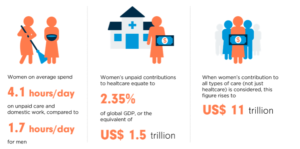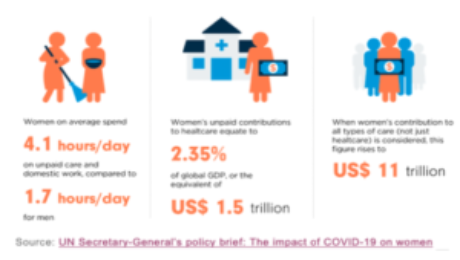UN Women: COVID-19 and the Crisis of the Care Economy
In a recent UN Women blog post, Silke Staab explores ways in which the COVID-19 pandemic that has swept the globe is further compounding the risk and strain put upon women in the care economy – both paid and unpaid.
Women comprise 70% of health workers globally and even higher shares of care-related occupations such as nursing, midwifery and community health work, which all require close contact with patients. The risks these front-line workers take to save lives are compounded by poor working conditions, low pay and lack of voice in health systems where medical leadership is largely controlled by men.
It is estimated that unpaid health care, in which the burden primarily fall onto women, is equivalent to a staggering $1.5 trillion globally. When factoring in all other types of care work, that figure climbs to $11 trillion. Furthermore, community health workers that receive no compensation, again mostly comprised of women, are vital to the health and wellbeing of communities all over the world. These care workers are in desperate need of proper equipment, training and financial support in the face of this current pandemic.

Source: UN Secretary-General’s policy brief: The impact of COVID-19 on women
The increased burden of childcare due to school closures and social distancing is also bound to negatively affect the well-being of the women taking on these tasks. This is further exacerbated by the loss of assistance from elders in the family, who must keep themselves protected from COVID-19 due to being in a vulnerable category.
On the flip side of that is the reliance of elderly people on the informal care of their family members, but this reliance puts them at greater risk of being exposed. Providing these family care workers with the proper assistance and protective gear in order to continue their duties while minimizing the risk to their loved ones is an essential first step in facing this particular challenge.
Although this pandemic has caused an immense strain on the care economy, the situation has created an opportunity to reevaluate priorities and reassess the economic value of these essential services being provided through care work. A people-centered plan for economic recovery should take this into account and prioritize long-overdue investments in the care economy.
Silke Staab is a research specialist at UN Women.
This blog was originally posted on the UN Women website on April 22, 2020. Read this blog post here.
- Published in COVID 19, Gender Inequalities, UN Women
A Gender Lens on COVID-19: Investing in Nurses and Other Frontline Health Workers to Improve Health Systems
In a recent CGD blog post, author Megan O’Donnell highlighted seven areas where long-run, gender-responsive thinking can help to insulate against the consequences of pandemics like COVID-19 and their disproportionate impacts on women and girls. Here we take a deeper dive into one of those areas: the promotion of a gender-equal global health workforce in which the occupations where women predominate, such as nursing and community health work, are valued, prioritized, and properly resourced.
Worldwide, women make up anywhere from 65 percent (Africa) to 86 percent (Americas) of the nursing workforce. Their jobs are critical to the health, safety, and security of communities on any given day, and particularly in times of a global pandemic. And yet, more obviously now than ever before, we face a global nursing shortage. To address this critical short fall and ensure sufficient numbers and distribution of health workers to provide both emergency and routine care in time of crisis, governments need to increase and improve their long-term investment in nurses, including by addressing gender gaps in the health workforce.
- Published in COVID 19, Gender Inequalities, Healthcare


